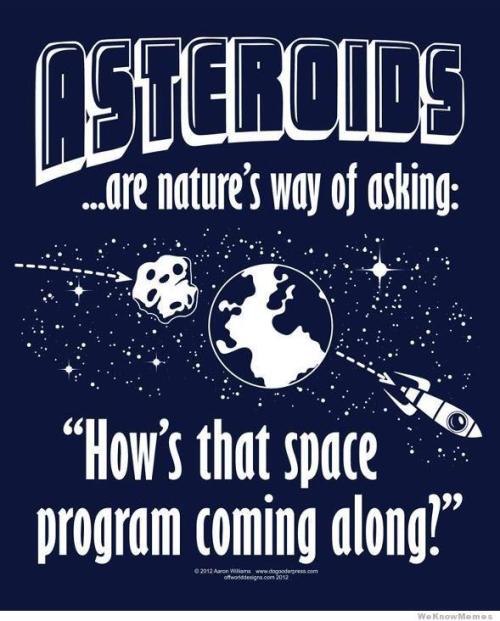
It's time to finish posting this week's space and astronomy news from Overnight News Digest: Science Saturday (West Antarctic ice sheet collapsing). There is enough for one more theme after composing Weather from space, Kids and animals in NASA's Global Selfies, and NASA on West Antarctic ice sheet collapsing--asteroid near misses and what to do about them.
Mike Wall of Space.com has both stories, beginning with Near Miss: Tiny Asteroid Gives Earth a Close Shave (Photos).
A small asteroid buzzed Earth Saturday (May 10), coming well within the orbit of the moon.That's an example of the problem. Here's a possible solution: NASA's Asteroid-Capture Mission May Test New Method to Defend Earth.
The near-Earth asteroid 2014 JG55 missed our planet by just 60,000 miles (96,560 kilometers), or about one-quarter of the distance between Earth and the moon. The flyby marked the third-closest asteroid near miss of 2014, researchers said.
The space rock was traveling about 22,000 mph (35,400 km/h) relative to Earth when it zipped past, they added.
NASA's bold plan to park an asteroid near the moon may also test out a new way to protect Earth from dangerous space rocks.Yes, bad news, good news. Follow over the jump for the rest of the news.
Last year, the agency announced that it intends to tow a near-Earth asteroid into a stable lunar orbit, where it could be visited repeatedly by astronauts for research and exploration purposes. NASA officials are still ironing out the details of the mission, which may bag up an entire small space rock or snag a boulder off the surface of a large asteroid.
If NASA decides to go with the boulder option, the asteroid-capture mission will also include a planetary-defense demonstration, providing the first in-space test of a so-called "enhanced gravity tractor," officials said.
It wouldn't be one of my weekly space news roundups without This Week @NASA: NASA Center Renamed on This Week @NASA
Two giants of aerospace history were honored at a May 13 ceremony to celebrate the renaming of Dryden Flight Research Center to Armstrong Flight Research Center, after the late Neil Armstrong and the naming of the center's aeronautical test range after Hugh Dryden. Armstrong was the first person to set foot on the moon and a former research test pilot at the center and Dryden served as NASA's first deputy administrator. Also, Space Station Crews on the Move, Asteroid Mission Gear Tested, Unstoppable Glacier Melt, Exploring Earth's Magnetic Fields, Shrinking Great Red Spot, Helicopter Drop Test, Technology Transfer University and more!
DarkSyde on Daily Kos had more general space news in This week in science: I see nothing!
Finally, Mike Wall of Space.com brings more good news in NASA's Exoplanet-Hunting Kepler Space Telescope Gets New Mission.
NASA's prolific Kepler spacecraft is back in action, a year after being sidelined by an equipment failure.And that completes the past week's space and astronomy news. Now it's time to gather this week's!
The space agency has approved a new mission called K2 for Kepler. The telescope's original exoplanet hunt was derailed in May 2013 when the second of the spacecraft's four orientation-maintaining reaction wheels failed, robbing it of its precision pointing ability.
"The approval provides two years of funding for the K2 mission to continue exoplanet discovery, and introduces new scientific observation opportunities to observe notable star clusters, young and old stars, active galaxies, and supernovae," Kepler Project Manager Charlie Sobeck, of NASA's Ames Research Center in Mountain View, California, wrote in an update today (May 16).
No comments:
Post a Comment